Tokyo Olympics 2021: Andrew Hoy eyes Brisbane 2032 Games swansong
Australia’s oldest Olympic medallist wants to take the “Usain Bolt” of horses to Paris, but don’t expect that to be Andrew Hoy’s swansong.
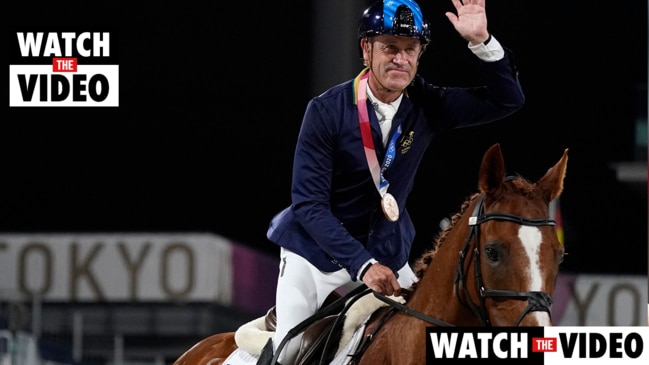
Olympics
Don't miss out on the headlines from Olympics. Followed categories will be added to My News.
Fresh from claiming his fifth and sixth medals in his eighth Olympics, Andrew Hoy has set his sights on riding Vassily De Lasso – the “Usain Bolt” of horses – to the Paris Games.
From there, who knows?
But Hoy will not rule out a bid to make it to the 2028 Games in Los Angeles – 44-years after making his Olympics debut at the 1984 event in ‘The City of Angels’.
When most people of his age are winding down, Hoy’s vigour remains as strong as ever.
Having finally hit the hay at 3am on Monday with his new bronze and silver medals resting beside him, the 62-year-old was up and at ‘em for his Tuesday morning press conference.
“Did you not know that 60 is the new 20,” he quickly retorted, when asked if he was “OK” with being Australia’s oldest Olympian to win a medal. “Well, the last time I was at a press conference with two medals was in 2000 – 21 years ago – so it is very special for me to be here and to share that experience.
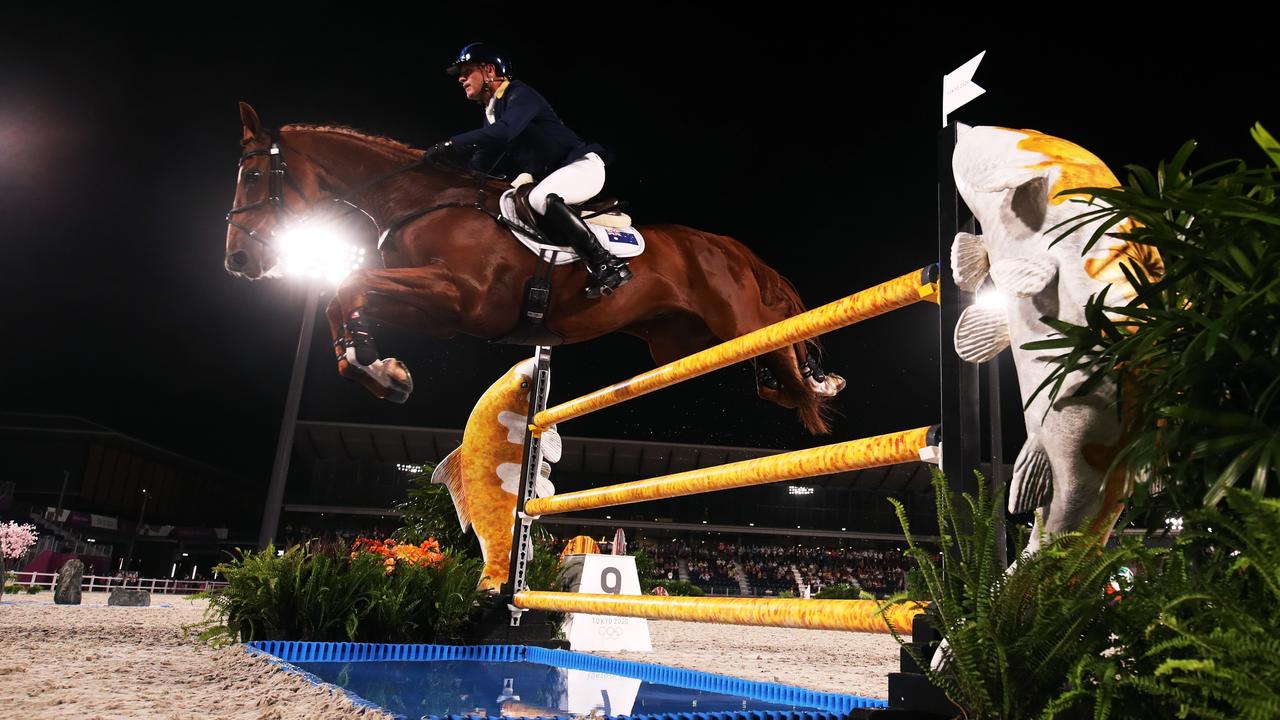
“Going back to your question about 2032, in between Paris and Brisbane is going to be Los Angeles, so there is a lot of work to be done.”
Ahead of his historic day out in Tokyo, Hoy’s daughter Philippa, who turned four on Tuesday, told her father to bring home a medal.
He didn’t let her down, and was later told by her that he did a “good job” in the cross country.
The boy from Culcairn, who quipped he might have to pay for an upgrade to the sign telling passers-by of the Riverina they were entering the ‘Home of Andrew Hoy’, puts his extraordinary feats down to his 12-year-old chestnut Vassily.
“Statistically, he is the fastest horse in the world with ratings that have been done,” Hoy said.
“In athletic terms, he would be the Usain Bolt of the equestrian industry. Moving on in years, I believe that Vassily De Lasso should he stay healthy and sound, and myself exactly the same, I believe that Paris is a very strong possibility for us to be there to represent this great country of Australia.
“This is what keeps me going in the industry: I’ve got a passion, a passion to work with the horse, and I love working with the animals.”

Vassily’s reward for his exceptional ride? Carrots, and more carrots. “Here in Japan, if you order carrots, they come in a beautiful box, beautifully clean, packed individually in the box,” Hoy said. “They’re quite big carrots, so I have to break them off while he eats them. But he knows he’s done a great performance, so extra carrots last night.”
Silver, bronze to legendary Aussie horseman Hoy
- Andrew Rule
Australia has now medalled in Tokyo over nine consecutive days after a brilliant performance from elder statesmen Andrew Hoy in the final of the eventing jumping teams final.
Hoy’s flawless exhibition in the showjumping ring on his dashing chestnut Vassily De Lassos nailed down a silver medal for an Australian team and an individual bronze in showjumping.
That takes Hoy’s Olympic medal tally to three gold, three silvers and a bronze from eight Olympic Games.
It began with the team’s superb effort in the cross country and showjumping despite starting behind scratch after being marked hard in the highly-technical dressage phase dominated by Great Britain and Germany.
The 62-year-old equestrian legend became Australia’s oldest Olympic medallist. He rode as well over jumps on a horse that’s probably as good as any he has ridden 40 years to help claim silver — but it wasn’t enough to claw back Great Britain’s gobsmacking lead in the final phase of the three-day-event.

After an almost flawless performance in the cross country phase on Saturday, the Australian trio — Hoy, Shane Rose and Kevin McNab and their mounts — were equally brilliant in the showjumping.
“It is very, very special,” Hoy said. “We don’t come to these championships, especially Olympic Games, to finish in fourth, fifth or sixth.
“We only come to get a medal and look, it’s been a complete team effort. And for sure Vassily De Lassos has done a wonderful job to finish on his dressage score.
“But if it wasn’t for Kevin, and also for Shane in the team, and this complete support team, we wouldn’t be here.
“It’s our high-performance team, it’s the Australian Olympic Committee behind us.”
Hoy’s polished and perfect round slightly shaded the superb English rider, Oliver Townend, on his big grey Irish sport horse, but nowhere near enough to make up for the Brits’ 18-point lead accrued on the dressage arena.
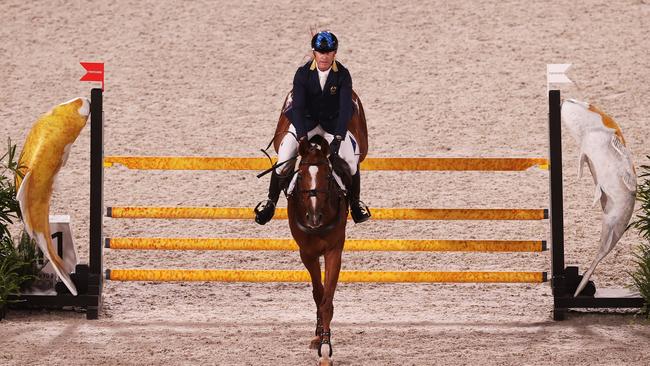
It was a remarkable performance from all three Australians and their mounts. The dashing horseman Rose on his horse Virgil “dropped” a rail and lost four points but their teammate McNab — “subbed in” to replace Stuart Tinney, whose horse took ill — was a picture of poise on Don Quidam.
McNab’s horse touched a jump but the rail did not fall and they finished the round without dropping a point.
Good as Rose and McNab are, landing the silver medal adds another chapter to the legend of Hoy, the shy and slightly-built boy from Culcairn in the Riverina area of NSW who gritted his teeth and turned himself into a giant of the equestrian world.
“I’ve got a fantastic horse. I know I’ve been to (eight) Olympics, but I’ve done it with fantastic horses and Vassily De Lasso is one of the world’s greatest horses,” Hoy added.
“He hasn’t won an individual medal at this point in time, but the way he runs cross country, the way he showjumps, it’s just little things I’m working on with the dressage to improve that, I believe he’ll be a (individual) medal winner himself.”
Hoy is not so much a performer as a legend in his eighth Olympics since his debut at Los Angeles in 1984.
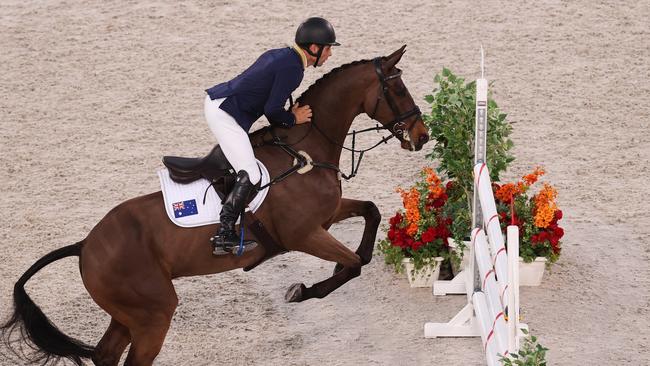
He first rode against the world’s best in the USA in 1978, on his “reject” thoroughbred Davey, a horse bred on a Queensland station and sold off cheaply as a stock horse after failing on the racetrack.
Hoy has trained himself and a long line of horses to excel against the best on the planet. He knows as much about spotting equine talent as almost anyone in the history of the sport, but also has the ability to find patrons and sponsors to back his judgment.
Then, say contemporaries who hung up their saddles years ago, he has proven he is a wonderful horse trainer.
Pedigree matters in horse sports, and not only for those with four legs. Hoy might have inherited his engineer father’s single-minded perfectionism, but he got his love of the animal from his mother, Dorothy.
She was the granddaughter of one of the finest trainers of stayers in Australia before the Cummings family came along. His name was Phil Heywood and apart from training the 1919 Melbourne Cup winner Artilleryman, he trained winners of derbies and of two Caulfield Cups.
And, perhaps significantly, Heywood was an accomplished jumping jockey in the late 19th century, when jumps races were immensely popular, extremely dangerous and attracted hundreds of fearless riders and horses.
In three years, Hoy will be 65. But his horse Vassily will be “only” 15, the prime of life for an eventer. They could be the first picked by Australia for the Paris Games.
The Hoy Story: The boy from Culcairn and the horse of a lifetime
It’s 1964 and Tokyo is poised to be the first Asian city ever to host the Olympics.
It is only 19 years since the atomic bombing of Hiroshima ended the Second World War. John F. Kennedy has been assassinated only months before, an English pop group called the Beatles is a new phenomenon and decimal currency is nearly two years from being introduced in Australia.
On the Hoy family farm in the Riverina area of southern NSW, Jim and Dorothy Hoy’s son, who has learned to ride a pony before he can read a book, is old enough to watch the Games on one of the first television sets in the district.
At five, Andrew Hoy can sense the excitement when Dawn Fraser wins her third consecutive gold in Tokyo. The odds against the boy becoming the second Australian to repeat Fraser’s feat are millions to one. But he will eventually do it … and more.
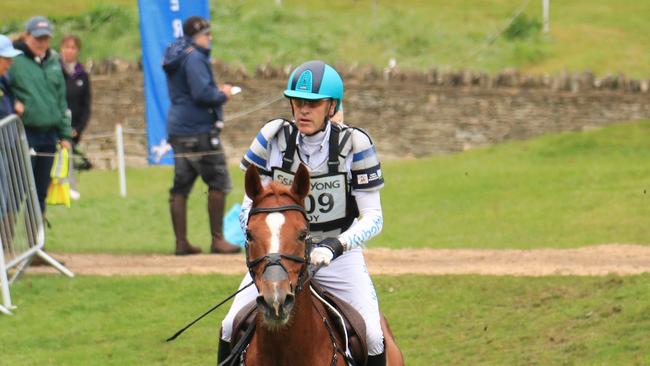
The Hoys are horse people and intensely interested in the equestrian team headed by the lean and laconic ex-Digger Bill Roycroft, hero of the 1960 Rome Games alongside his swashbuckling mate Laurie Morgan.
In the post-war era, Australia is known not just for swimmers and tennis players but horses and riders who punch above their weight. Apart from Roycroft, there is the prodigiously talented and confident all-rounder Morgan, who could play football, box and ride a bucking bull as well as he could pilot a jumping horse.
The Hoy boy inherits his love of horses from his mother, Dorothy. She is a Heywood, granddaughter of Phil Heywood, a racing trainer who won the 1919 Melbourne Cup with his Derby winner, Artilleryman. Before Phil learns the art of training stayers, he is a fine cross-country jockey.
Apart from Artilleryman, Heywood trains two Caulfield Cup winners. In an era when many old-time trainers feed and work gallopers like cavalry horses, Heywood is a thinker who prepares his racehorses with finesse and polish.
History repeats. There are similarities between Andrew Hoy and his great grandfather, who trained horses to Derbies and Cups.
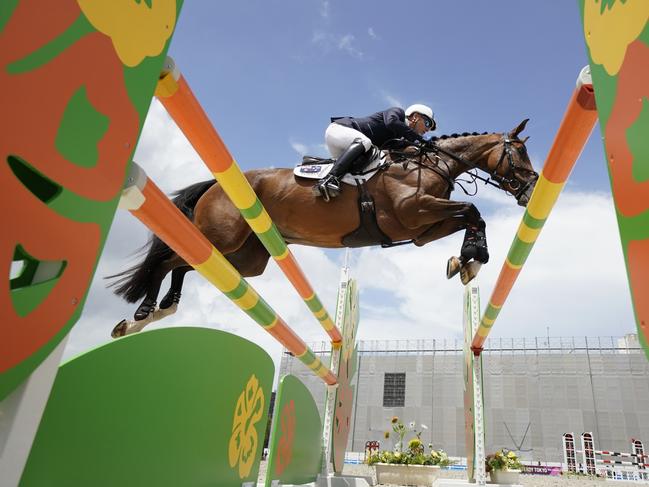
David Brideoake is an expert witness on both Hoy and horse training. Brideoake, the successful racehorse trainer, is a former international equestrian, a showring contemporary of Hoy’s since their schooldays competing against each other. The Brideoakes are from Lockhart, not far from the Hoy farm at Culcairn, between Albury and Wagga.
Brideoake admires Hoy’s longevity and dedication. He has watched Hoy mould himself into an elite rider with persistence and practice. But mostly he sees Hoy as a master horse trainer who ingrains the right habits into a horse and eliminates its faults with years of patient preparation.
At 62, says Brideoake, the kid from Culcairn has got himself the horse of a lifetime. This is the courageous chestnut Vassily De Lassos — bred in France, owned by English patrons and poised to perform for Australia.
“To tell you the truth,” says Brideoake, “I think Andrew was probably the first chosen for the team.”
Hoy isn’t the oldest member of the Australian contingent — that is fellow equestrian, dressage specialist Mary Hanna, who is 66 and up for her sixth Olympics.
Dressage is often compared with ballet on horseback — highly technical and skilled but about as dangerous as golf. Whereas to ride over huge fences against the clock is something that takes nerve, reflexes and balance at any age, let alone an age when most people retire to take up lawn bowls.
Hoy is returning for his eighth Olympics since his first at Los Angeles in 1984. That’s quite some achievement. But here’s the thing: the only reason he missed Beijing in 2008 and Rio in 2016 was that he didn’t have the right horse in those years. And in 1980, the 20-year-old Hoy was already a world-class talent all set to ride at the Moscow Games until prevented by the boycott over the Soviet invasion of Afghanistan.
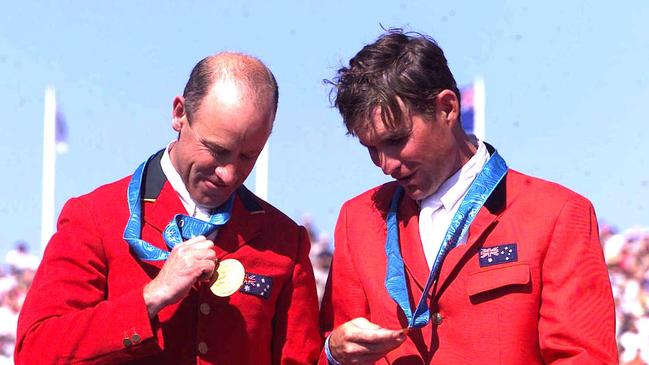
In other words, Tokyo could easily have been Hoy’s 11th Olympic Games. That is astonishing. So is the fact that if he and the outstanding Vassily De Lassos perform well and hold their form, they will be in the running for the Paris Games in three years. “Vassily” is only 12 years old in a sport in which the youngest horses are 10 and many are older than 15.
It’s about the horseflesh. Finding and developing the right horses. Elite equestrian horses command eye-watering sums that require riders to have either state backing, hugely wealthy families, major sponsors or patrons with pockets the size of saddlebags.
It’s no coincidence that the daughter of the late billionaire Alan Bond, Susanne, was a leading showjumper. And Bill Gates’s daughter Jennifer and Bruce Springsteen’s daughter Jessica. Not to mention Princess Anne and her daughter Zara Tindall.
Money can’t buy you love, but it buys lovely horses and without those, all the training, skill, courage and nerve in the world won’t take a great rider to the top.
Hoy is a three-day-eventer, not a specialist showjumper. Eventing is for all-rounders, with the cross country phase a direct descendant of the cavalry charge, the hunting field and amateur steeplechasing. Then there’s showjumping around a twisting circuit of high obstacles shoehorned into a tight arena. And there’s dressage, antidote to the adrenaline of cross country and the extreme athleticism of the show jumping ring.
Horses and riders are not naturally equally good at all three disciplines. What Hoy did, decades ago, was eliminate the weaknesses in his show jumping technique and then to apply the same discipline to teaching horses to be as well-prepared as he is.

The well-polished Hoy story is that he competed at his first shows at seven on a borrowed pony and swiftly rose up the pony club ranks to top grade three-day-eventing.
His first outstanding horse was Davey, named after a farmer called “Dave”, who’d bought him cheaply from a trainload of horses shipped south from the Queensland border in a drought in the early 1970s.
Davey was a station-bred thoroughbred tried briefly for racing. Dave the dairy farmer used him to go around the cows near Wangaratta before selling him to the Hoys, who saw something in the spirited little horse.
By luck or judgment or both, as a teenager Hoy had a horse that could take him to international eventing. His only sister Jennifer had died in a riding accident as a child, and the feeling among his contemporaries is that he might have turned his back on the equestrian life after that tragedy.
Hoy doesn’t speak publicly about his sister’s death. But the way he talks about Davey with such affection suggests that the brave little jumper gave him the motivation to get back on the horse, literally and figuratively. Back in the saddle, he seemed determined to make every competition count.
The harder he worked, the luckier he got. Hoy and Davey went overseas in 1978. At 20, they won their first elite four-star event. Davey was Hoy’s entry ticket to the global eventing world. He grabbed it with both hands.
In the words of his knockabout contemporary Greg McDermott, who combined shearing with showjumping for 15 years, Hoy was “mates” with Captain Mark Phillips, then husband of Princess Anne and a leading European eventing rider and coach.
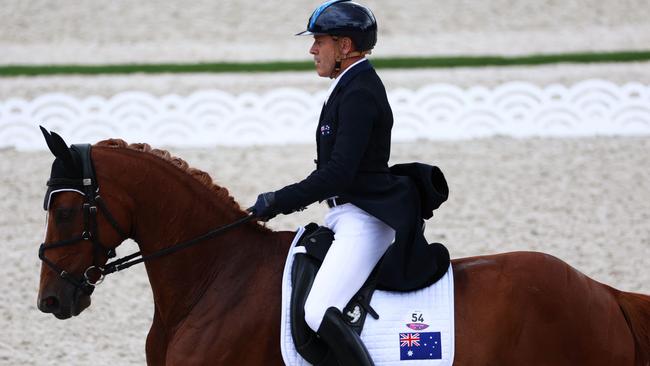
Being able to lodge his team at Princess Anne’s Gatcombe Park estate gave him a walk-up start in the business of cultivating sponsors and patrons. He was as good at developing patrons as he was at training their horses. Well-spoken and polite, he was no rough diamond and he took care to fit in with polished performers both in the saddle and out of it.
None of that surprises those who rode the country show circuit with him as teenagers. McDermott’s memory of his polite opponent is that Andrew’s father would put plastic bags over his highly-polished boots to stop any flecks of mud or dust, then leg him up into an impeccable saddle. That infinite capacity to take pains became Andrew’s default setting.
McDermott recalls Hoy analysing himself and deciding to concentrate on showjumping for months at a time to hone his style to the level of some naturally more gifted jumping riders.
Along the way, of course, Hoy has attracted those essential collaborators, the horses. After Davey, the names of his best mounts are familiar echoes from Games past. There is Kiwi, the dual Olympic horse he found in New Zealand after backing the other Kiwi, Snowy Lupton’s chestnut, to win the 1983 Melbourne Cup. There are Gershwin and Swizzle In and the great grey Darien Powers, bred by prominent racing man Bob Scarborough. Now there is “Vassily” the free running chestnut, bred in France, trained in England and all set to perform for Australia.
Ask Hoy about his longevity and he prefers to talk of horses. “It hasn’t been about me breaking records as to how many Olympics I can compete at — I just want to keep learning and improving,” he said in a special pre-Games interview.
“I am driven by high performance and attention to detail … so it seems as if it’s seamless.”
When he and the eventing team won Gold in Sydney, the crowd chanted “Aussie, Aussie, Aussie — Hoy, Hoy, Hoy.” Don’t bet it can’t happen again.





